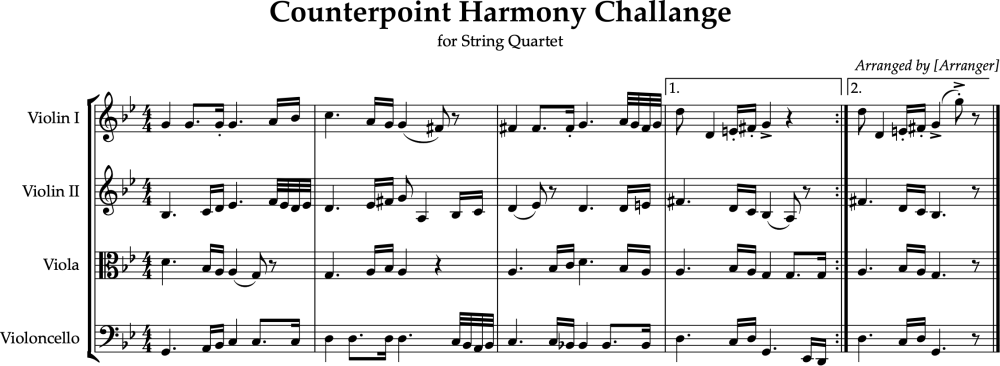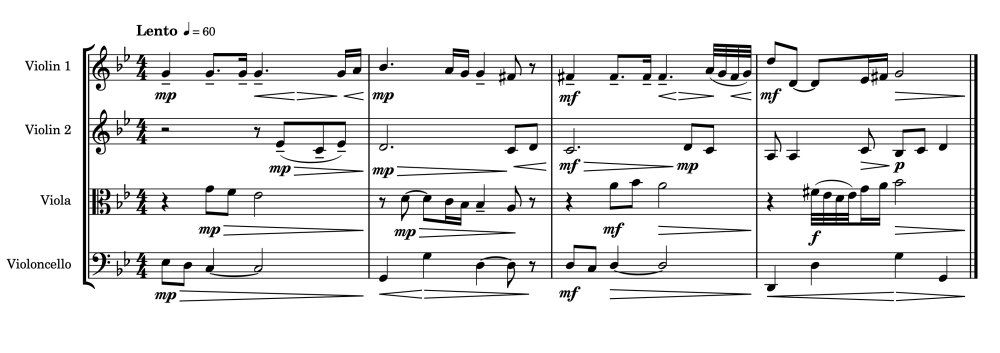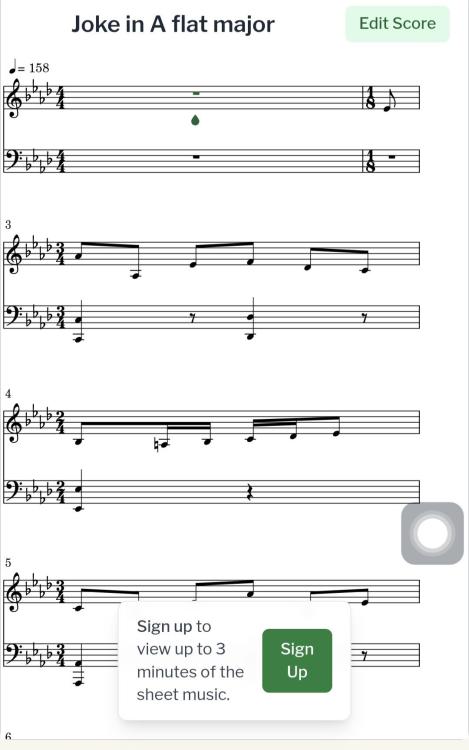All Activity
- Past hour
-
.thumb.png.8b5b433a341551e913a34392660bc95b.png)
Jane, for piano
PeterthePapercomPoser replied to Samuel_vangogh's topic in Incidental Music and Soundtracks
Hi @Samuel_vangogh! You made this art? It looks great! The music is wonderful too! The delaying of the resolution to the tonic through repeated ii - V's is to me a very cool feature. The ending is quite unusual as well and despite not ending on the tonic, it still sounds finished. Also, something I noticed is that (at least in the beginning) the piece seems to be in the Acoustic mode (or Lydian b7 or Mixolydian #4). But there's plenty of chromaticism as well. The simplicity but exploration of non-harmonic tones is also a bit Satie-like. Thanks for sharing! P.S.: would you post a link to your artwork, if possible as a high resolution image? That would be really great! Thanks in advance! - Today
-
.thumb.png.8b5b433a341551e913a34392660bc95b.png)
Canon a 4 for String Quartet in F minor.
PeterthePapercomPoser replied to Fugax Contrapunctus's topic in Chamber Music
Hey @Fugax Contrapunctus! Great idea! I really like how the canon starts on the dominant, making the F minor tonality only a later emergent property of the harmony arising from the counterpoint. I think the Musesounds strings are a bit difficult to deal with to get them to sound as intended. I wonder why you changed the articulation to staccato as each new voice enters when it wasn't staccato in the Cello? It would make the entry of each voice more obvious I think if they entered on a fully held quarter note. The beginning and ending of the canon, I think are the best parts. But the middle could really have used some space/rests in the line to imo to give the ear an occasional break from the barrage of constant melodic material that demands to be digested by the ears. Thanks for sharing! -
Chemathmusician0510 started following Quick little harmony/counter-point mini-challenge :)
-
Quick little harmony/counter-point mini-challenge :)
Chemathmusician0510 replied to UncleRed99's topic in Challenges
-
.thumb.png.8b5b433a341551e913a34392660bc95b.png)
Fughetta in C minor for String Quartet.
PeterthePapercomPoser replied to Fugax Contrapunctus's topic in Chamber Music
Hi @Fugax Contrapunctus! I think your hours of labor on this unusual subject really paid off! I think the subject and the counter-subject are really well matched with each other with one moving while the other rests on quarter notes. It creates a kind of question/answer dichotomy between the voices and increases their independence. I think this is one of the best fugues you've written and seems really mature and less mechanical. It's very fluid, natural and spontaneous. The only thing that bothers me is the ending on a feminine cadence. I felt like the last chord came too early and should have been reserved for the strong beat of the next (non-existent) bar. Thanks for sharing! -
.thumb.png.8b5b433a341551e913a34392660bc95b.png)
Raptors in the Grass
PeterthePapercomPoser replied to Layne's topic in Orchestral and Large Ensemble
Hey @Layne! Your harmony and main theme are full of tension! And the piece is saturated with the theme throughout. But you do have a contrasting middle section that doesn't use the main theme for a brief moment. I'm surprised nobody has mentioned this yet but your main theme sounds a lot like the theme to "Back to the Future", especially with the first 3 notes (F, Bb, E). Thanks for sharing! -
Debussy orchestration (Footsteps in the Snow)
MJFOBOE replied to Alex Weidmann's topic in Orchestral and Large Ensemble
Alex - overall both are very good orchestrations of the piano work. After listening to the piano work, I found, I missed the resonance of the lower notes vibrating (pedal). I'm not sure how to reproduce this quality in the lower winds and/or lower strings etc. Mark - Yesterday
-

Quick little harmony/counter-point mini-challenge :)
Luis Hernández replied to UncleRed99's topic in Challenges
Interesting. Your version sounds great. Although for me, that Gb “desperately calls” for an F#, which is part of the dominant chord. Best regards. -
Alex Weidmann started following Debussy orchestration (Footsteps in the Snow)
-
Hi to everyone. This week I've been working on an exercise to orchestrate Debussy's Prelude No.6 from Book 1. I came up with two versions, one with a very restricted instrumentation, and the other with a larger ensemble. Interested to know which you think works best? The final bass dyad was very problematic, due to its extreme low pitch. It sounded too intrusive and twangy in the harp, and seemed off-pitch in the double-bass, with a horrible grating timbre. Eventually I decided to remove the lowest note altogether in the version with restricted instrumentation, and have the upper note pizz. instead of arco.
-
UncleRed99 started following Henry Ng Tsz Kiu
-
UncleRed99 started following Quick little harmony/counter-point mini-challenge :)
-
Not sure if this is the right place for this post, but I came across something, quite simple but still fun. Was browsing youtube and stumbled upon a video. At the very beginning, the creator presented a 4 bar line of a Violin melody. (I've altered it a slight bit to make it a tiny bit more interesting. the original challenge melody reused the 1st measure, except with the same 4 32nd notes you see at the end of bar 3. I elected to simply change it to Gb, rather than staying on the G. I also included an ending 1 and a fine measure to sort of round it out a bit more. Here is the Challenge Melody): The instrumentation to be used for this challenge includes Vln. 1 & 2, Viola, and Cello. 4 Staves, with Vln. 1 already written for ya. Just curious to see what everyone else comes up with 🙂 Here is mine! I'm not a virtuoso or a master so mine will probably pale in comparison to some of yours. Lets see it! Harmony Challenge.mp3
- Last week
-
PeterthePapercomPoser started following Doodle For String Orchestra
-
.thumb.png.8b5b433a341551e913a34392660bc95b.png)
Vignettes of a Day Trio Oboe Viola Piano
PeterthePapercomPoser replied to MJFOBOE's topic in Chamber Music
Mark, I think what I mean by artificiality is that the notes lay flat on the page. It might be partly a result of you conceiving of the music as a visual structure. One has the impression that one is hearing a work meant to be experienced all at once, since it seems to have been conceived that way, in a sense. The same thing is true of Stravinsky imo. He worked at the piano and there's an essay somewhere out there about how the piano heavily influenced how he conceived of his music. There's sometimes a certain lack of fluidity where the music spontaneously surprises the listener at each moment of its playing. That's what I experience when I listen to some of your music and I interpret that as a certain artificiality. Thanks for asking! -
Some Guy That writes Music started following Doodle For String Orchestra
-
I enjoyed the opening theme, harmonies and mood you created in the work. Personally, I would have enjoyed a bit more variation/contrast (in context) on the presenting theme. I think it would have added a bit more tension/dimension to the work. Mark
-
Hi Peter, Thanks for listening! For the bells, I was using a preset called Old Memories on GarageBand's Sun Glitters Pad. There's definitely some detuning at work; but I didn't have control over it as such. The work uses three different presets on this pad; but I don't think I used any automation between presets as the music evolved. Instead I just put them on different tracks. If I was remaking it now, I think I would use some automation to make it even more weird!
-
Peter, Thanks for the lovely comments. Would you please expound of your use of "artificial" in the context of my work and how it relates to Stravinsky. Mark
-
Peter, Thanks for the review. My compositions can be a bit dense ... I have been actively working to address this ... Ironically, the ending of this work was edited/re-orchestrated to lessen the density and bring out the more prominent thematic material; however, it did leave the ending with less of a punch. I have another version with more density and more satisfying ending. So I will once again I will review the work to create a better build up punch at its conclusion ... balancing both aspects of the work. Also, thanks for the kind words about my style! I don't know if the way I compose/orchestrate influences my style. For me the score sheet - is a way to build the architecture of the work - in a sense I am a very visual composer. Mark
-
.thumb.png.8b5b433a341551e913a34392660bc95b.png)
Romance for Orchestra
PeterthePapercomPoser replied to Some Guy That writes Music's topic in Orchestral and Large Ensemble
Hi @Some Guy That writes Music! I love the song-like quality of the music and the breathtaking modulations! Some of the melodies sometimes sound like they're wandering around aimlessly up and down the scale in step-wise motion which doesn't make for a very interesting melodic content. Other times you break away from the step-wise motion and the music seems much more romantic and purposeful there. Although I guess the other extreme of avoiding step-wise motion would be to skip around to chord tones. Of course, that wouldn't be interesting either all the time. But you do show some good choice use of non-harmonic tones on strong beats to really bring out their beauty. Thanks for sharing. I really enjoyed the romantic flourishing and I loved the quiet ending! -
Hi @Fugax Contrapunctus! This perhaps makes me think of a slow funeral march with its metronomic regularity and depth of emotion. I usually try to try to steer clear of orchestrating stuff the way you've done here where the choir is basically just doubled by the strings and woodwinds. You seem to have made it work, but I wonder if that will translate to a real performance. Perhaps with a careful balancing of the orchestra and a formidable enough choir, the orchestra won't drown the choir out. But you seem to have deliberately omitted the brass which might have been too forceful for the venue and the nature of the music, so I guess it's best to leave them tacit. Thanks for sharing!
-
Hi @mercurypickles! I really love the lyrical 2nd song! Perhaps they're both lyrical. The 1st song is lyrical in that it seems to continue a logical leading melodic line despite seemingly constant tempo changes. But you make it sound quite natural and smooth and beautiful. Thanks for sharing!
-
Hi @Alex Weidmann! I really love the tubular-bell/chimes in the latter half of the piece. Are you using microtones at all in this? The bells sound kinda cool and a bit out of tune. Thanks for sharing!
-
.thumb.png.8b5b433a341551e913a34392660bc95b.png)
Vignettes of a Day Trio Oboe Viola Piano
PeterthePapercomPoser replied to MJFOBOE's topic in Chamber Music
Hey Mark @MJFOBOE! Nice succinct multi-movement piece! I especially like the 11 pm falling asleep section - probably because of the close connection you have in that part to memories of your daughter. I also like how the piece starts over again as the new day dawns. I would have expected a dream-like sequence after the 11 pm falling asleep section though - could have made for some really interesting music! I also really liked the 3/4 hemiolas in the morning rush section. There is a peculiar artificiality to your musical style (I'm not meaning this at all as a negative comment though just an observation). Once again, I can't help but compare this artificiality of your style to Stravinsky. Thanks for sharing! -
Hi Mark @MJFOBOE! I think your individual style really shines in this piece. In your other pieces, your style can be a bit dense and hard to digest. It's a bit like Stravinsky in that it's a style one has to get used to. But once one does, and in this piece especially, it really has its own unique logic and beauty! The way you extend and repeat your motifs in this piece is a really unique kind of development. The piece also seems like it's constantly building towards that final chord. Although I did find it personally a bit lacking, like a whole fanfare finale/codetta could have maybe made it sound more conclusive. Those are my thoughts. Thanks for sharing!
-
chris11six joined the community
-
I really enjoyed your percussion writing .... Mark
-
Hi all .... Here's composition that I began a few years back; however, I really never finished to my satisfaction. So he's my latest version .... all comments/criticisms/suggestions as well pleasantries are welcome. Mark
-
AC123 joined the community








